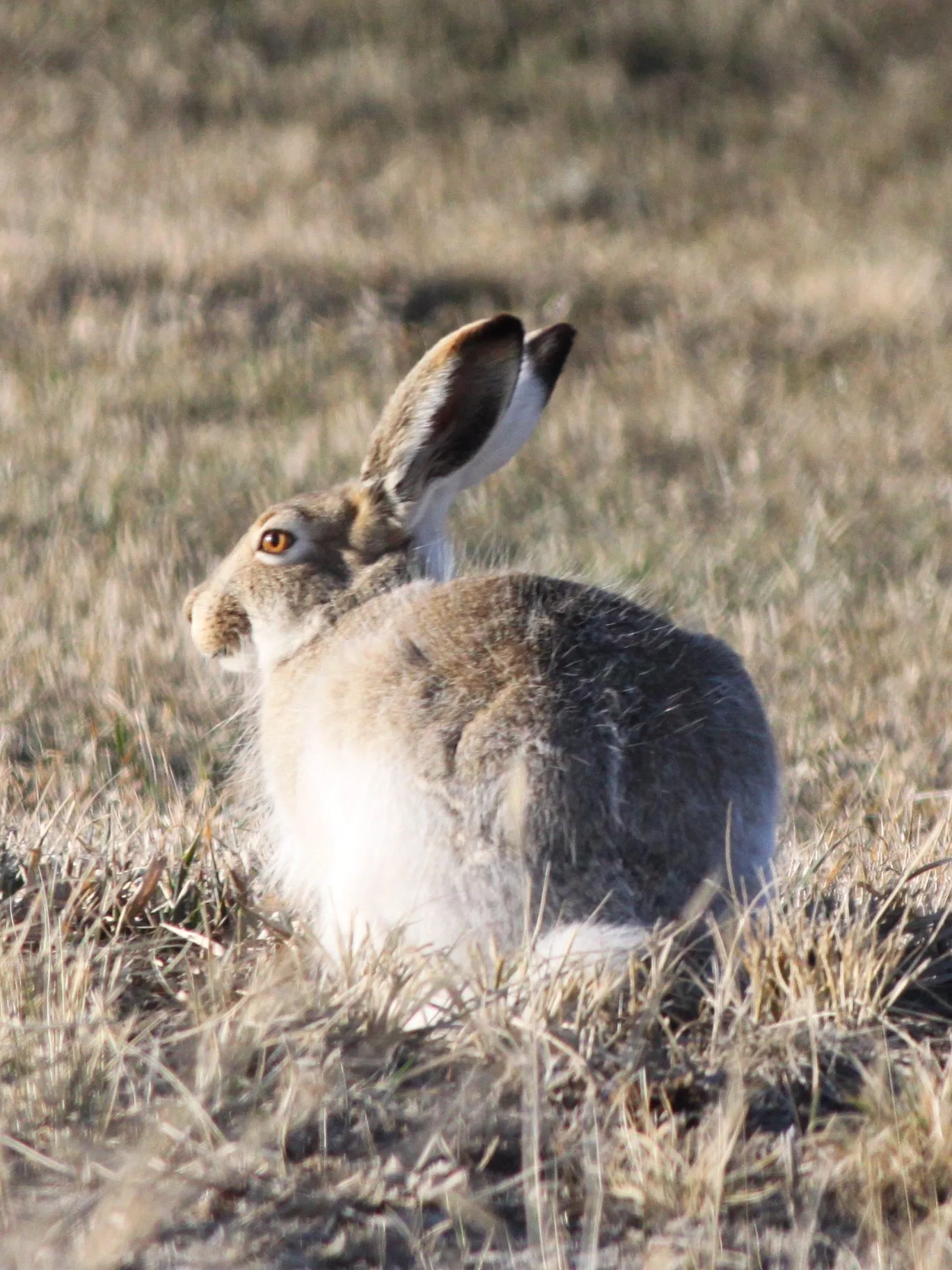
Spring Shades. Jackrabbits will change their coats from white to gray as spring approaches, and make the switch back in fall as photoperiod triggers hormones in their body that adjust the coloration of their fur to help them better hide from predators in each season. Simonson Photo.
By Nick Simonson
From the attention paid by my dogs as we walk the last paved road on the edge of town in the pre-dawn darkness of winter’s coldest nights, I know they’re there. Usually in a pair or a trio, but sometimes in a group of five, the resident jackrabbits hold steady until we’ve crossed the outer edge of their comfort zone and they bound off like white ghosts against the snowy backdrop toward the unmowed edge of the field grass beyond the development lots and the last glimmer of the final streetlight. The mere fact they’re out in temperatures below negative thirty degrees shows they’re well adapted to handle the cold, and that they’ve evolved to exploit the dark of their nocturnal proclivities, and shows what a specialized creature they are in our range, according to RJ Gross, Upland Game Biologist for the North Dakota Game & Fish Department (NDG&F).
“They were blessed with fantastic insulation. There’s a reason why back in the settlement days, that people had rabbit fur gloves, hats, and everything like that, just because it’s a fantastic insulator. So, this just feels like another day to them,” Gross relates of jackrabbits’ ability to withstand the cold.
Another neat adaptation which jackrabbits use is protective coloration which shifts along with the seasons. Going from a dusky gray in summer to a snow white to match the winter landscape, these species of hares are able to blend in and avoid predators throughout the year; that is unless the backdrop doesn’t match their coat, as some late-arriving winters can leave them exposed. That’s because changing day length – and not temperature or weather conditions – trigger the shift in color.
“Almost everything in the animal kingdom is triggered by photoperiod, which is the amount of daylight every day. In the wintertime, and in fall coming into winter, the daylight gets less and less, and that triggers jackrabbits to change their coat. That’s why unfortunately – like last year, when we didn’t have snow – that gives them a bad disadvantage because now they stick out in brown grass and they’re bright white. But usually in wintertime they’re more white, the snow’s white and they blend in; that’s their main defense mechanism against predators,” Gross explains.
In addition to their seasonally-acquired camouflage, jackrabbits have many other characteristics which help them evade predators. Their highly-sensitive whiskers help them detect motion in the world around them. Their powerful muscles and strong legs – especially their hind legs – can propel them with mighty leaps and bounds up to speeds of 40 miles per hour when fleeing predators, the most common of which in the upper Midwest are coyotes and foxes. Those back legs too also allow them incredible leaping capabilities, able to eclipse more than 10 feet in a single jump. But perhaps the most advantageous feature of these unique animals is their powerful eyes, which can see movement at great distances and operate well in low light conditions.
“They have really good eyesight, and they use their whiskers quite a bit so they can detect a lot of movement and things like that. And then just less things are out, obviously still some of the predators are also nocturnal, but for the most part, it’s so they can use their specialized eyesight,” Gross details of the night movements of jackrabbits.
In North Dakota, the jackrabbit is a seldom-pursued hunting target, though Gross relays stories of groups of hunters from the eastern U.S. who frequent the Peace Garden State to hunt them. As they are a non-game species in the state, residents don’t need a license to hunt them, and out-of-state hunters need only a non-game stamp. NDG&F keeps loose tabs on jackrabbit populations in the state via the agency’s summer roadside counts which are typically focused on pheasant chick production, and through accumulated rural mail carrier tallies of wildlife sightings, which do include jackrabbits.
